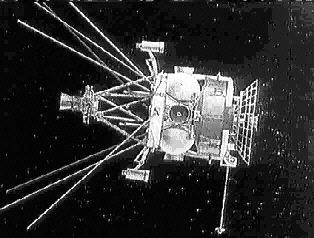 Abstract
Abstract Abstract
AbstractThe analysis of Soviet ASAT tests presented here is not intended to replace other excellent works on this subject, such as (5) and (6), but rather to complement these works and add some new dimensions to the analysis. Orbital data for the relative motion plots below have been obtained from NASA's Orbital Information Group and, when such data were missing, from my own archives and those of Mr Geoff Perry. The software used to generate the plots is an as yet unpublished version of my mission analysis software SMX (Space Mission eXpert).
Polyot 1 was launched from Baikonur at about 0850 UT on 1 November 1963. It transmitted FSK-PDM telemetry signals on 19.945 MHz that were picked up by observers in the West. The Sohio Research Lab in Cleveland tracked Polyot 1 on revolution 3,4,5,11,12, and 13 (11). The transmitter seemed to have ceased operating on 3 November. In a telegram dated 2 November 1963 TASS gave the initial orbit to be 339-592 km, but no inclination was announced. The final orbit was given by TASS as 343-1437km, i = 58 92 degrees from which the spacecraft decayed in 1982.
Polyot 2 was launched from Baikonur at about 0920 UT on 12 April 1964. The orbit was announced by TASS on 13 April as 310-500km at 58.06 deg, which is the final orbit. The corresponding Western figures are 303-479 km. The initial orbit was measured by Western sensors to be 242-485 km at i = 59.92 degrees. Thus, perigee was raised and the inclination was changed by 1.86 degrees. Such a plane change required a delta-v of 250 m/s, which required about 125 kg of propellant (if the spacecraft weighed 1400 kg at ignition). It transmitted FSK-PDM telemetry on 19.895 MHz. The Sohio Research Lab in Cleveland again picked up signals and reported that they went silent on 15 April 1964 (12). The spacecraft decayed in 1966.
At the time these two launches were certainly not associated with the ASAT program. they were seen as manoeuvring tests in preparation for manned rendez-vous and docking operations. TASS called both satellites "manoeuvring spacecraft" in news releases. The three-year interval until testing resumed also confused observers.
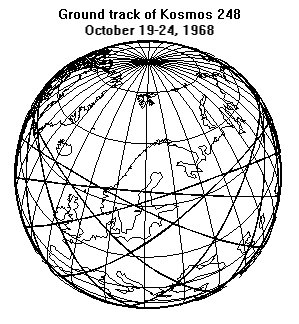 This
test took place in October 1968 and used Kosmos 248 as the target. The
launch of Kosmos 248 around 0420 UT on 19 October 1968 was very similiar
to that of Kosmos 217 in that no rocket stage was left in orbit and the
orbital parameters (476-543 km, i = 62.25 deg) were extremely close to
those announced for Kosmos 217 (but never achieved).
This
test took place in October 1968 and used Kosmos 248 as the target. The
launch of Kosmos 248 around 0420 UT on 19 October 1968 was very similiar
to that of Kosmos 217 in that no rocket stage was left in orbit and the
orbital parameters (476-543 km, i = 62.25 deg) were extremely close to
those announced for Kosmos 217 (but never achieved).
An interesting feature of the orbit of Kosmos 248 is that it had a "stabilized ground track", i..e the ground track repeated itself on the globe every day (See figure on the right). A repeating pattern orbit is described by four parameters:
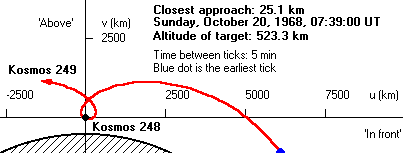 Kosmos
249 was launched around 0400 UT on 20 October 1968 and initially
entered a transfer orbit with 104.7 km perigee and 138.2 km apogee. On
the first revolution the orbit had changed to 502 km perigee and 1639 km
apogee. On revolution 2 the intercept orbit had been established with perigee
at 489 km and apogee at 2167 km. So, Kosmos 249 "attacked" Kosmos 248 from
"in front" and "above". According to Russian sources the interceptor repeatedly
approached the target. No orbital data to support this claim exists. Russian
sources also say that it was blown up to test the destruct charge. Indeed,
109 fragments were detected in orbit by Western sensors (6).
Kosmos-252 was launched on 1 November 1968 and approached Kosmos 248 in
a manner highly reminiscent of that of Kosmos 249. After the intercept
the main piece of Kosmos 252 was in an orbit between 531 km and 2149 km.
There were 139 fragments left in orbit after the intercept.(5)
Kosmos
249 was launched around 0400 UT on 20 October 1968 and initially
entered a transfer orbit with 104.7 km perigee and 138.2 km apogee. On
the first revolution the orbit had changed to 502 km perigee and 1639 km
apogee. On revolution 2 the intercept orbit had been established with perigee
at 489 km and apogee at 2167 km. So, Kosmos 249 "attacked" Kosmos 248 from
"in front" and "above". According to Russian sources the interceptor repeatedly
approached the target. No orbital data to support this claim exists. Russian
sources also say that it was blown up to test the destruct charge. Indeed,
109 fragments were detected in orbit by Western sensors (6).
Kosmos-252 was launched on 1 November 1968 and approached Kosmos 248 in
a manner highly reminiscent of that of Kosmos 249. After the intercept
the main piece of Kosmos 252 was in an orbit between 531 km and 2149 km.
There were 139 fragments left in orbit after the intercept.(5)
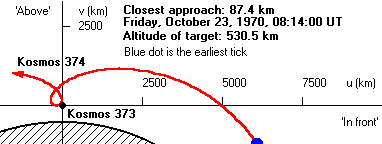 The
second intercept test, using Kosmos 373 as a target, was a virtual
repeat of the first test, except that the inclination was raised slightly
from 62.3 degrees to 62.9 degrees. The target, Kosmos 373, launched on
20 October 1970, was again put into an orbit with a stabilized ground track.
This permitted the use of almost identical flight profiles for the two
interceptors - clearly a simplifying condition, but not a very good simulation
of real targets. The orbital parameters were initially 474-542 km
with a nodal period of Tn=94.77 min. In preparation for
the second interceptor its orbit was raised slightly to 460-563 km with
a nodal period of Tn=94.83 min. The first interceptor Kosmos
374 was launched at around 0445 UT on 22 October 1970 and followed a flight
profile very similar to those flown by Kosmos 249 and 252, i.e. it attacked
the target "from in front" and "from above". An intermdiate orbit at 530-1053
km was detected by radars in the West. The figure below shows that the
target was approached shortly after 0800 UT on 23 October, 1970 along an
intercept orbit at 529-2132 km altitude.
The
second intercept test, using Kosmos 373 as a target, was a virtual
repeat of the first test, except that the inclination was raised slightly
from 62.3 degrees to 62.9 degrees. The target, Kosmos 373, launched on
20 October 1970, was again put into an orbit with a stabilized ground track.
This permitted the use of almost identical flight profiles for the two
interceptors - clearly a simplifying condition, but not a very good simulation
of real targets. The orbital parameters were initially 474-542 km
with a nodal period of Tn=94.77 min. In preparation for
the second interceptor its orbit was raised slightly to 460-563 km with
a nodal period of Tn=94.83 min. The first interceptor Kosmos
374 was launched at around 0445 UT on 22 October 1970 and followed a flight
profile very similar to those flown by Kosmos 249 and 252, i.e. it attacked
the target "from in front" and "from above". An intermdiate orbit at 530-1053
km was detected by radars in the West. The figure below shows that the
target was approached shortly after 0800 UT on 23 October, 1970 along an
intercept orbit at 529-2132 km altitude.
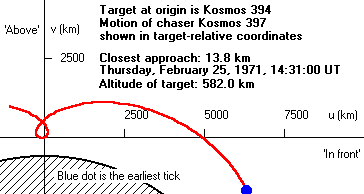 Test
Nr 3 (1971): Kosmos 394 - a new type of target is destroyed by first interceptor
Test
Nr 3 (1971): Kosmos 394 - a new type of target is destroyed by first interceptorThe launch of Kosmos 397 interceptor took place on 25
February 1971, much longer after the launch of the target than previous
interceptors. The initial orbit had a 65.1 degree inclination which was
changed to the 65.84 degrees inclination of the target. The intercept took
place about 1431 UT the same day as can be seen from the graph below. The
interceptor performed the final approach along an orbit at 575-2200 km.
Eighty-two (82) fragments were later discovered in the elliptical orbit
(6). In summary, this intercept is relatively
similar to previous tests. No second inteceptor was launched, indicating
that the target was indeed destroyed?
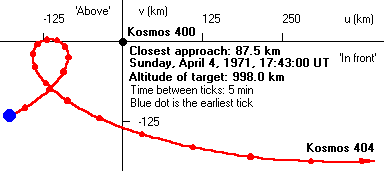 Test
Nr 4 (1971): Kosmos 400 target simulates U.S. Transit Navsats?
Test
Nr 4 (1971): Kosmos 400 target simulates U.S. Transit Navsats?Kosmos 404 was launched around 1420 UT on 4 April 1971 and approached Kosmos 400 sometime between 1745 and 1800 UT on 4 April. The approach took place from "below" along a 803-1010 km orbit. This was the first approach from below. About 12 hours after the approach (around 0930 UT on 5 April 1971) the interceptor was commanded to maneuver down into a 169-799 km orbit when it passed over ground stations on the Soviet Pacific coast. This orbit had changed to the 126-661 km when NORAD determined its orbit at 1140 UT 6 May 1971. With such a low perigee Kosmos 404 decayed soon afterwards. The figure below shows a large miss distance, but in all probability, the interceptor orbit used to generate this graph is not accurate. During these intercept tests, Western sensors often had little time to refine the orbital parameters.
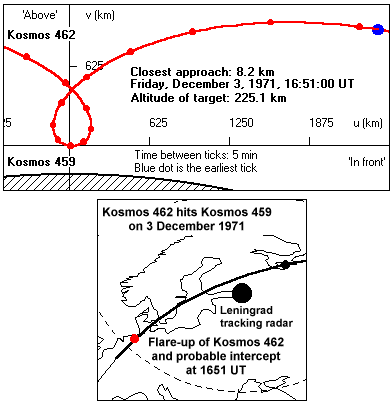 The
Kosmos 459 target was launched from Plesetsk on 29 November 1971 into a
223.2 - 260.2 km orbit maybe simulating a low-orbit photo reconnaissance
satellite. The Kosmos 462 interceptor was orbited on 3 December. It entered
a higher orbit (231.4-1655) km than its target. On its second orbit around
the earth the interceptor approached its target from "in front" and "above"
as the figure below shows.
The
Kosmos 459 target was launched from Plesetsk on 29 November 1971 into a
223.2 - 260.2 km orbit maybe simulating a low-orbit photo reconnaissance
satellite. The Kosmos 462 interceptor was orbited on 3 December. It entered
a higher orbit (231.4-1655) km than its target. On its second orbit around
the earth the interceptor approached its target from "in front" and "above"
as the figure below shows.
The figure shows that Kosmos 462 missed Kosmos 459 by only 8.2 km at 1651 UT, but we now know that there was an intercept, so the orbit of Kosmos 462 needed only to have been adjusted very little in relation to the one which forms the basis of the figure below.
Interestingly, in May 1973, I received a call from UFO enthusiasts in southern Sweden. They reported that on 3 December 1971 observers in Sweden's southernmost county, Skane, and in Copenhagen had observed a bright object in the sky coming from the southwest that suddenly flared up abruptly at 1651 UT (see figure below). The flare lasted about 20 seconds and then gradually faded.
The RAE Table of Earth satellites gives the time of closest
approach between Kosmos 459 and Kosmos 462 as Dec 3.70, i.e. 1650 UT and
our analysis here shows the intercept to have taken place at 1651 UT! It
is interesting to note that Kosmos 462 entered eclipse at 16:51:22 . It
seems that the UFO-ists observed the intercept and destruction of the target
and the interceptor!
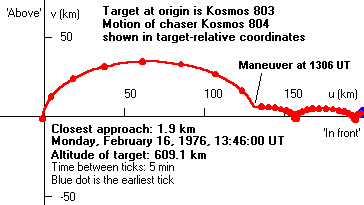 There
was a five-year long break in ASAT testing after the failure of the target
Kosmos 521 launched in September 1972. This lull in testing was due to
the fact that the Strategic Arms Limitation Treaty was signed between the
Soviet Union and the U.S. in May 1972. The launch of Kosmos 521 was not
stopped by the signature of the Treaty, but its failure must have "come
in handy" when the decision was taken to discontinue testing. According
to (5) the purpose of the Kosmos 521 target was to test modifications to
the interceptor design.
There
was a five-year long break in ASAT testing after the failure of the target
Kosmos 521 launched in September 1972. This lull in testing was due to
the fact that the Strategic Arms Limitation Treaty was signed between the
Soviet Union and the U.S. in May 1972. The launch of Kosmos 521 was not
stopped by the signature of the Treaty, but its failure must have "come
in handy" when the decision was taken to discontinue testing. According
to (5) the purpose of the Kosmos 521 target was to test modifications to
the interceptor design.
However, in 1976, a new generation of interceptors had been designed and testing resumed (5). A new type of target had also been developed, called IS-P. The first such target, Kosmos-803 was launched 12 February 1976 into an orbit at 554-618 km and 65.85 degrees inclination. This orbit was similar to that of earlier targets, in particular that of Kosmos 394. Its ground track was not stabilised. The first interceptor, Kosmos-804, was launched 16 February 1976 and followed an entirely new approach! First it entered the typical low-perigee "transfer orbit" (149-703 km, i=65.15 deg, at 08:19:35 UT). Then the orbit was matched relatively well to the target orbit (561-619 km, i=65.86 deg, at 09:53:35 UT ) providing a slow approach to Kosmos 803 (as can be seen on the right in the figure below. Then, at about 1306 UT the final half-orbit approach was performed quickly along an 530-623 km, 65.75 deg orbit. Upon reaching the target - "from above" (!) - there was a braking maneuver and the interceptor rendez-voused with the target (see picture of motion) and maintained a 556.3-615.3 km, 65.86 deg orbit for more than 3 hours (until about 1610 UT).
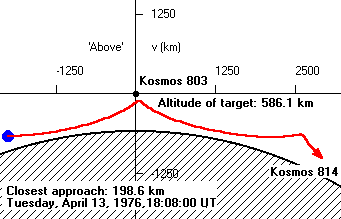 Kosmos
814 was launched on 13 April 1976 - almost two months after the first interceptor.
Only one set of orbital parameters is available and it shows an approach
to the Kosmos 803 "from below". The orbital paarmeters of this element
set are 117-480 km at 65.1 degree inclination. This is the initial "transfer"
orbit and a as can be seen from the figure below amaneuver had to follow
to bring the interceptor reasonably close to the target.
Kosmos
814 was launched on 13 April 1976 - almost two months after the first interceptor.
Only one set of orbital parameters is available and it shows an approach
to the Kosmos 803 "from below". The orbital paarmeters of this element
set are 117-480 km at 65.1 degree inclination. This is the initial "transfer"
orbit and a as can be seen from the figure below amaneuver had to follow
to bring the interceptor reasonably close to the target.
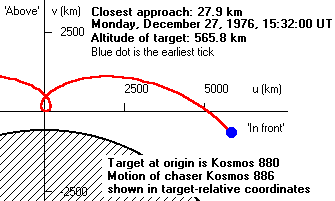 Test
Nr 8 (1976): Rerun of an earlier test scenario - Kosmos 880 is the target
Test
Nr 8 (1976): Rerun of an earlier test scenario - Kosmos 880 is the targetAccording to (6) this test involved the fragmentation
of the interceptor and (6) also suggests that "the resumption of tests
may have been timed to coincide with the SALT talks but it is also possible
that this fragmentation test was staged to impress the Carter Administration."
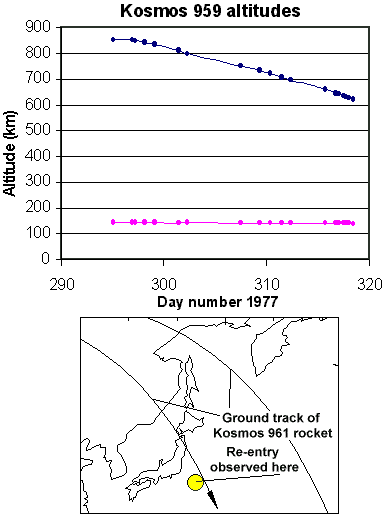 Test
Nr 10 (1977): A "pop-up" test against Kosmos 959 gives rise to UFO reports
in Japan
Test
Nr 10 (1977): A "pop-up" test against Kosmos 959 gives rise to UFO reports
in Japan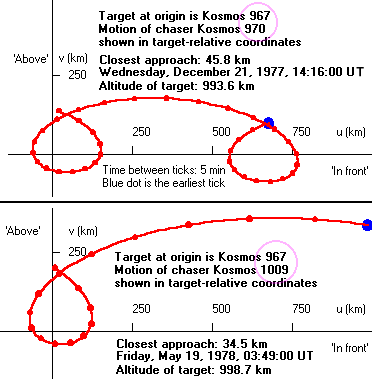 Kosmos
967 launched on 13 Dec 1977 into 964-1005 km, 65.83 deg, very similar to
that of Kosmos 400 back in 1971. Kosmos 970 was launched on 21 December
1977 into an intermediate orbit at 158-744 km, 65.1 deg. Kosmos 970 intercepted
Kosmos 967 around 1416 UT on 21 Dec 1977 along an orbit at 949-1149 km
(i=65.85 deg). This was a relatively slow approach - sometimes called a
co-orbit intercept. The interceptor was commanded to self-destroy (5),
but not near the target, since the target was used once again.
Kosmos
967 launched on 13 Dec 1977 into 964-1005 km, 65.83 deg, very similar to
that of Kosmos 400 back in 1971. Kosmos 970 was launched on 21 December
1977 into an intermediate orbit at 158-744 km, 65.1 deg. Kosmos 970 intercepted
Kosmos 967 around 1416 UT on 21 Dec 1977 along an orbit at 949-1149 km
(i=65.85 deg). This was a relatively slow approach - sometimes called a
co-orbit intercept. The interceptor was commanded to self-destroy (5),
but not near the target, since the target was used once again.
The second interceptor launch against Kosmos 967 was delayed by a record amount of time - more than five months. Thus, Kosmos 1009 was launched on 19 May, 1978 and also approached the target rather slowly along an orbit at 966-1363km i = 65.87 deg. the closest approach took place at 0349 UT. According to (5) the interceptor was de-orbited using its own engine over the Western Pacific after 0.17 days in orbit. The re-entry was near 10 N, 147 E.
The Kosmos 967 target remained in orbit waiting for the second intercept for an unusually long time and this is the satellite reported in (1). This satellite was reported to have transmitted in the autumn of 1979(!). In (1) it was indicated that the transmitter on 145 MHz was not always active, but at intervals of two months. The ascending node rotated 24 hours in local time in about 6 months. This could affect the time when transmissions were heard. Obviously the transmissions from the target satellites were heard frequently by radio amateurs, since complaints were wide-spread. However, Soviet interference on radio wave-bands was not uncommon in those days. Many of us remember the so-called "woodpecker" Soviet experimental shortwave "over-the-horizon"-radar that spread the most horrendous interference all over shortwave bands, so this bandwidth-limited and time-limited intrusion on the 2-meter band pales in comparison!
| Test Nr 12 (1980) - three
intercept tries!
Test nr 12 commenced with the launching of Kosmos 1171
into the typical approximately circular target orbit at 1000 km on 3 April
1980. According to (5) the following interceptor
launch was made to test the ability of an interceptor to perform after
a long period of storage. When Kosmos 1174 was launch on 18 April 1980
a drama in space unfolded displaying new capabilities of the Soviet ASAT
system. When the initial intercept failed, the interceptor was maneuvered
to perform two more intercept attempts. the table below shows that the
futile attack on Kosmos 1171 lasted 1.5 days.
The first intercept attempt was performed from "below and behind" on rev. 2 of the interceptor, and took place over northern Russian near the city of Surgut . The attempt failed and orbital data seem to indicate a miss distance of tens of kilometres. However, ground controllers recouped quickly from this setback, and commanded a manoeuvre that brought the interceptor back to the target 16 hours later off the Californian peninsula. This time the approach was made from "in front" but the interceptor approached from above along the radius vector. Again the interceptor missed the target and again ground control, extremely quickly commanded another manoeuvre. This must have been a quick-reaction effort, since the failed intercept occurred at 2204 on 18 April 1980 and the manoeuvre took place at 0035 on 19 April 1980. The pass over the Soviet Union when the manoeuvre could have been commanded took place at 2310-2330 UT on 18 April! Anther slow approach was performed taking about 12 hours to complete, resulting in another missed intercept at 1257 UT on 19 April 1980 over the Pacific near Samoa. This disappointing test ended on 20 April 1980 when the interceptor was commanded to destroy itself. An interesting feature of this test is the wide separation of the intercept points. Two of them were definitely out of range of Soviet tracking means, since it seems improbable that Soviet space engineers could have planned the second and third intercept attempt and placed tracking ships at those location. Rather, the target and the interceptor itself must have recorded data to show the results of the approach and this data was read out when passing over Soviet ground stations. |
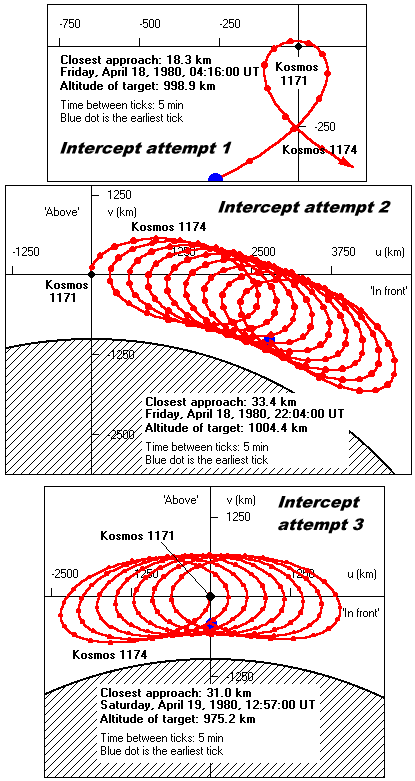 |
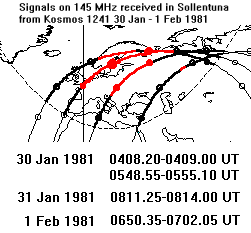 With
Kosmos 1241 I was finally able to pick up signals from an ASAT target.
Signals on 145 MHz was picked up from my home in Sollentuna, Sweden on
30 and 31 January and 1 February 1981 (See map). On 21 January 1981 this
target had been inserted into the typical 977-1011 km orbit at 65.8 degrees
inclination - very similar to that of the previous target.
With
Kosmos 1241 I was finally able to pick up signals from an ASAT target.
Signals on 145 MHz was picked up from my home in Sollentuna, Sweden on
30 and 31 January and 1 February 1981 (See map). On 21 January 1981 this
target had been inserted into the typical 977-1011 km orbit at 65.8 degrees
inclination - very similar to that of the previous target.
It was natural to assume that the upcoming interceptor would be launched at the same orbital phasing as Kosmos 1174 had in relation to Kosmos 1171. The previous target had a northbound equator crossing longitude (NBECL) of 40.71 E (319.29W) when the interceptor was launched. Kosmos 1241 would get close to this longitude on 2 February 1981 when its NBECL was 318.9 W.
In this way, I was able to be prepared for the launch of the interceptor. Since the target passed over Sweden early in the morning, I did not need to take the morning off from work. As soon as I picked up the target signal on 145 MHz at 0345.39-0356.35 UT I switched the discone antenna to another receiver with which I tuned across the 55-260 MHz range. Since satellites launched by the Tsiklon booster usually transmitted on 166 MHz, I was not overly surprised to find typical PPM-AM telemetry on this frequency at 0358.20-0402.40 UT.
This was indeed exciting! An interceptor had in all probability been launched! Would its signals appear at the same time as those from the target on the following revolution - normally the intercept revolution? I must say I held my breath an hour and a half later. The target telemetry appeared faithfully at 0530.10 UT and the 166 MHz signal started at 0531.40 UT. The two signals grew in strength and faded out almost simultaneously at 0544.56 (target) and 0544.50 (interceptor) at 2 degrees elevation.
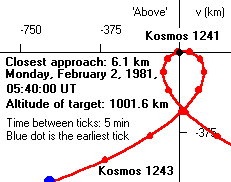 An
interceptor, Kosmos 1243, had indeed been launched early in the morning
and the closest approach took place at 0540 UT well within view of my station.
Actually the elevation from Sollentuna at the moment of closest approach
(50 meters according to 5) occured when
the two craft were 35 degrees above my horizon and at a slant range of
1584 km. (see map
showing signals 2 February 1981) The interceptor approached the target
along an orbit at 296-1016 km, i.e. it apprached from "below and behind".
According to (5) the explosive charge did not
go off as planned and the interceptor was guided to a destructive re-entry
into the earth's atmosphere.
An
interceptor, Kosmos 1243, had indeed been launched early in the morning
and the closest approach took place at 0540 UT well within view of my station.
Actually the elevation from Sollentuna at the moment of closest approach
(50 meters according to 5) occured when
the two craft were 35 degrees above my horizon and at a slant range of
1584 km. (see map
showing signals 2 February 1981) The interceptor approached the target
along an orbit at 296-1016 km, i.e. it apprached from "below and behind".
According to (5) the explosive charge did not
go off as planned and the interceptor was guided to a destructive re-entry
into the earth's atmosphere.
A second intercept of Kosmos 1241 was made at about 1645
UT on 14 March 1981 when Kosmos 1258 was launched and approached Kosmos
1241 along an orbit (290-1025 km, 65.82 deg) almost identical to that of
Kosmos 1243. The closest appraoch took place at 2014 UT, but the intercept
was unsuccessful (5).
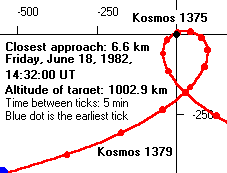 The
test in 1982 was designed to evaluate the system performance after storage
(5). The target, Kosmos 1375 was launched on
6 June 1982 into an orbit very similar to previous targets (980-1013 km,
65.84 deg). Target telemetry was again picked up in by radio amateurs (3).
I was well aware of the launch opportunity for the interceptor - 12 days
after the target as with Kosmos 1243. Indeed Kosmos 1379 was launched at
about 1105 UT on 18 June 1982. I had rushed home from work to try to pick
up the target and the interceptor. Strangely enough I did not hear the
target on 145 MHz, but heard the interceptor telemetry on 166 MHz at 1243.05-1245.10
UT. The closest approach occurred at 1432 UT and was successful (5).
The
test in 1982 was designed to evaluate the system performance after storage
(5). The target, Kosmos 1375 was launched on
6 June 1982 into an orbit very similar to previous targets (980-1013 km,
65.84 deg). Target telemetry was again picked up in by radio amateurs (3).
I was well aware of the launch opportunity for the interceptor - 12 days
after the target as with Kosmos 1243. Indeed Kosmos 1379 was launched at
about 1105 UT on 18 June 1982. I had rushed home from work to try to pick
up the target and the interceptor. Strangely enough I did not hear the
target on 145 MHz, but heard the interceptor telemetry on 166 MHz at 1243.05-1245.10
UT. The closest approach occurred at 1432 UT and was successful (5).
With this flight 19 years of testing ended and the system
never flew in space again. Presumably it was kept in readiness at Baikonur
for quite a number of years, perhaps to be replaced by an air-aunched similar
to the U.S. system.
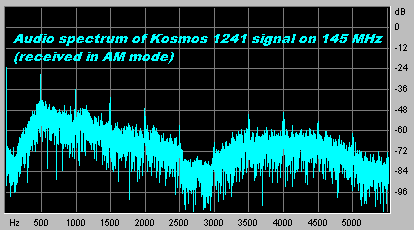
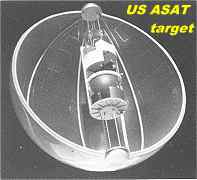 It
could be interesting to compare the few known facts about the Soviet ASAT
target satellite with the equally meagre information about the target developed
for the U.S. ASAT program in the 80's. The ASAT vehicle that was carried
under an F-15 fighter was supposed to have attacked two targets launched
by a Scout rocket from Wallops Island. The targets were indeed launched
but never used (the Solwind satellite was used instead). The only information
about their technical details has been gleaned from a publicity brochure
published by LTV (10)
. The two Instrumented Target Vehicles (ITV) were launched by the same
Scout (S-207) on 12 December, 1985 (into a 319-768 km, i = 37.1 deg orbit).
The spacecraft contractor was Avco Systems Division (Wilmington, Mass)
and each spacecraft weighed 81.6 kg. The central body dimensions were 0.46
m in diameter and 1.07 m in length. The diameter of the balloon was 1.83
m. Only ITV2 deployed its balloon.
It
could be interesting to compare the few known facts about the Soviet ASAT
target satellite with the equally meagre information about the target developed
for the U.S. ASAT program in the 80's. The ASAT vehicle that was carried
under an F-15 fighter was supposed to have attacked two targets launched
by a Scout rocket from Wallops Island. The targets were indeed launched
but never used (the Solwind satellite was used instead). The only information
about their technical details has been gleaned from a publicity brochure
published by LTV (10)
. The two Instrumented Target Vehicles (ITV) were launched by the same
Scout (S-207) on 12 December, 1985 (into a 319-768 km, i = 37.1 deg orbit).
The spacecraft contractor was Avco Systems Division (Wilmington, Mass)
and each spacecraft weighed 81.6 kg. The central body dimensions were 0.46
m in diameter and 1.07 m in length. The diameter of the balloon was 1.83
m. Only ITV2 deployed its balloon.
As can be seen from the figure here the spacecraft central body was encapsulated in a balloon like structure. The balloon surface seemed to have embedded in it something that looks like a an antenna system. The "ramparts"-like structure of the conductor in the balloon skin seems to indicate a rather low frequency - perhaps a VHF frequency not very far from the 145 MHz used by the Soviet ASAT target. probably this was the antenna of the miss distance indicator system. The large structures on the balloon surface would not disturb the radiation pattern of e.g. S-band telemetry antennas on the central spacecraft body.
Another capability of the target must have been to store the scoring data on board for later read-out over ground stations. This is obvious if one looks at the locations of intercepts. Not all took place within easy view of Soviet ground stations or tracking ships as can be seen in the figure below (which shows some of the intercept locations). What kind of data recorder was used? A tape recorder?
In (5) reference is made to manoeuvres by the targets. Kosmos 373 is stated to have manoeuvred twice. Actually, this spacecraft is the only target that shows any signs, albeit weak, of manoeuvring. Maybe the early targets, being derivatives of the interceptor could manoeuvre, while the later models, being much smaller, probably could not.
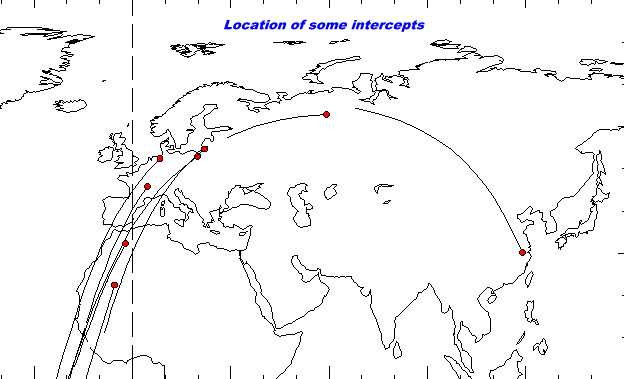
As can be seen from the formulas below the miss-distance (d) can be estimated and the sideways course-correction impulse computed by observing range, range-rate, and angular motion of the interceptor relative to the target. In order to obtain good angular motion data the interceptor needs to be well stabilised with low angular body rates. As can be seen the miss-distance (d) is brought to zero if the angular motion of the interceptor relative to the target (the motion of the line-of-sight) is eliminated by a sideways velocity impulse. This is the reason for the four lateral thrusters seen on the interceptor.
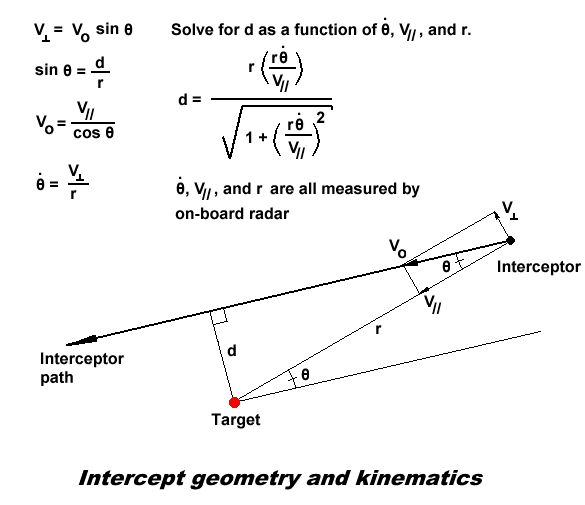
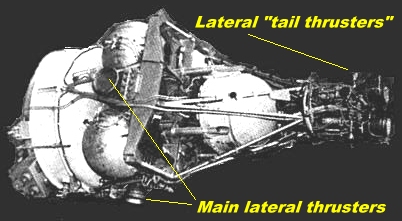
In Western reports about the Soviet ASAT tests reference
was often made to an optical guidance system for the interceptor (5)
starting with Kosmos 967. However, Russian sources never mention such a
guidance scheme. As can be seen from the analysis above, an optical sensor
could not derived the value for the sideways impulses since the range-rate
was difficult to estimate. Why did Western intelligence refer to optical
guidance? Because they failed to detect the radar signals from the interceptor?
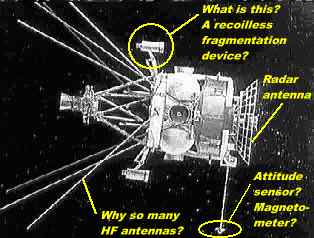 A
few remarks on the interceptor configuration
A
few remarks on the interceptor configurationThe small boom probably holds a magnetometer, but it could be some kind of device working together with the device seen at the lower left part of the picture above - maybe a mirror to work with horizon sensors mounted on the body?. The mesh-type radar antenna is clearly not intended for high frequencies (low surface accuracy), so the assumption made earlier that the carrier frequency is near 1 GHz seems reasonable
| Cat
Nr |
Int'l
desig- nator |
Name | Launch
date |
Incl. | Hp (km) | Ha
(km) |
End | Remarks |
|---|---|---|---|---|---|---|---|---|
| 683 | 1963-043A | Polyot-1 | 1 Nov 1963 | 58.92 | 343 | 1437 | - | Interceptor engine test. Initial: 339-592 km |
| 783 | 1964-019A | Polyot-2 | 12 Apr 1964 | 58.06 | 303 | 479 | - | Interceptor engine test. Initial: 242-485 km, 59.92 deg |
| 3013 | 1967-104A | Kosmos-185 | 27 Oct 1967 | 64.09 | 518 | 873 | - | Test of interceptor engine only. |
| 3216 | 1968-036A | Kosmos-217 | 24 Apr 1968 | 62.20 | 144 | 262 | - | Injection into final orbit failed |
| 3503 | 1968-090A | Kosmos-248 | 19 Oct 1968 | 62.25 | 476 | 543 | - | |
| 3504 | 1968-091A | Kosmos-249 | 20 Oct 1968 | 62.33 | 489 | 2167 | S | Intermed orbits:105-138 km, 502-1639 km |
| 3530 | 1968-097A | Kosmos-252 | 1 Nov 1968 | 62.32 | 531 | 2149 | F | |
| 4058 | 1969-066A | Kosmos-291 | 6 Aug 1969 | 62.24 | 147 | 548 | - | Wrong target orbit due to engine failure |
| 4590 | 1970-087A | Kosmos-373 | 20 Oct 1970 | 62.93 | 474 | 542 | - | Target orbit raised slightly after 1 w. |
| 4594 | 1970-089A | Kosmos-374 | 22 Oct 1970 | 62.96 | 529 | 2132 | S | Initial orbit:530-1053 km |
| 4598 | 1970-091A | Kosmos-375 | 30 Oct 1970 | 62.80 | 525 | 2098 | S | Initial orbit: 566-994 km |
| 4922 | 1971-010A | Kosmos-394 | 9 Feb 1971 | 65.84 | 572 | 614 | - | New, smaller, type of target. |
| 4964 | 1971-015A | Kosmos-397 | 25 Feb 1971 | 65.76 | 575 | 2200 | F | |
| 5050 | 1971-020A | Kosmos-400 | 19 Mar 1971 | 65.85 | 987 | 1002 | - | First attack from below |
| 5113 | 1971-027A | Kosmos-404 | 4 Apr 1971 | 65.74 | 803 | 1010 | D | Moved to 169-799 km after approach |
| 5625 | 1971-102A | Kosmos-459 | 29 Nov 1971 | 65.83 | 223 | 260 | - | |
| 5646 | 1971-106A | Kosmos-462 | 3 Dec 1971 | 65.88 | 231 | 1655 | F | |
| 6206 | 1972-074A | Kosmos-521 | 29 Sep 1972 | 65.89 | 965 | 1022 | - | Target. TM system failed. (5) |
| 8688 | 1976-014A | Kosmos-803 | 12 Feb 1976 | 65.85 | 554 | 618 | - | New IS-P target (5) |
| 8694 | 1976-015A | Kosmos-804 | 16 Feb 1976 | 65.75 | 530 | 622 | D | "Rendez-voused" with the target |
| 8806 | 1976-034A | Kosmos-814 | 13 Apr 1976 | 65.07 | 117 | 480 | D | No intercept orbit available |
| 9011 | 1976-067A | Kosmos-839 | 9 Jul 1976 | 65.86 | 984 | 2098 | - | |
| 9043 | 1976-071A | Kosmos-843 | 21 Jul 1976 | 65.11 | 131 | 341 | D | No intercept orbit available |
| 9601 | 1976-120A | Kosmos-880 | 9 Dec 1976 | 65.85 | 560 | 617 | - | Similar orbit to Kosmos 394 |
| 9634 | 1976-126A | Kosmos-886 | 27 Dec 1976 | 65.84 | 596 | 2297 | F | Intermed. orbit 533-1267 km |
| 10010 | 1977-036A | Kosmos-909 | 19 May 1977 | 65.87 | 991 | 2107 | - | Very similar to Kosmos 839 |
| 10014 | 1977-037A | Kosmos-910 | 28 May 1977 | 65.10 | 149 | 506 | D | No intercept orbit available. Rocket orbit given here. |
| 10065 | 1977-050A | Kosmos-918 | 17 Jun 1977 | 65.11 | 128 | 244 | D | No intercept orbit available. |
| 10419 | 1977-101A | Kosmos-959 | 21 Oct 1977 | 65.84 | 145 | 854 | - | |
| 10434 | 1977-104A | Kosmos-961 | 26 Oct 1977 | 66 | 269 | 1421 | D | Intercept orbit not confirmed. Initial: 125-302 km. |
| 10512 | 1977-116A | Kosmos-967 | 13 Dec 1977 | 65.83 | 964 | 1005 | - | |
| 10531 | 1977-121A | Kosmos-970 | 21 Dec 1977 | 65.85 | 949 | 1149 | S | Interm. orbit 158-744 km, 65.1 deg |
| 10904 | 1978-050A | Kosmos-1009 | 19 May 1978 | 65.87 | 966 | 1363 | D | Another "slow" approach |
| 11750 | 1980-026A | Kosmos-1171 | 3 Apr 1980 | 65.84 | 967 | 1010 | - | |
| 11765 | 1980-030A | Kosmos-1174 | 18 Apr 1980 | 65.83 | 363 | 1026 | S | Initial: 124-340 km, 65.1;After: 380-1660, 66.1 |
| 12149 | 1981-006A | Kosmos-1241 | 21 Jan 1981 | 65.82 | 977 | 1011 | - | |
| 12160 | 1981-010A | Kosmos-1243 | 2 Feb 1981 | 65.82 | 296 | 1016 | D | Explosive charge failed. |
| 12337 | 1981-024A | Kosmos-1258 | 14 Mar 1981 | 65.82 | 290 | 1025 | D | |
| 13259 | 1982-055A | Kosmos-1375 | 6 Jun 1982 | 65.84 | 980 | 1013 | - | |
| 13281 | 1982-060A | Kosmos-1379 | 18 Jun 1982 | 65.84 | 538 | 1020 | D |